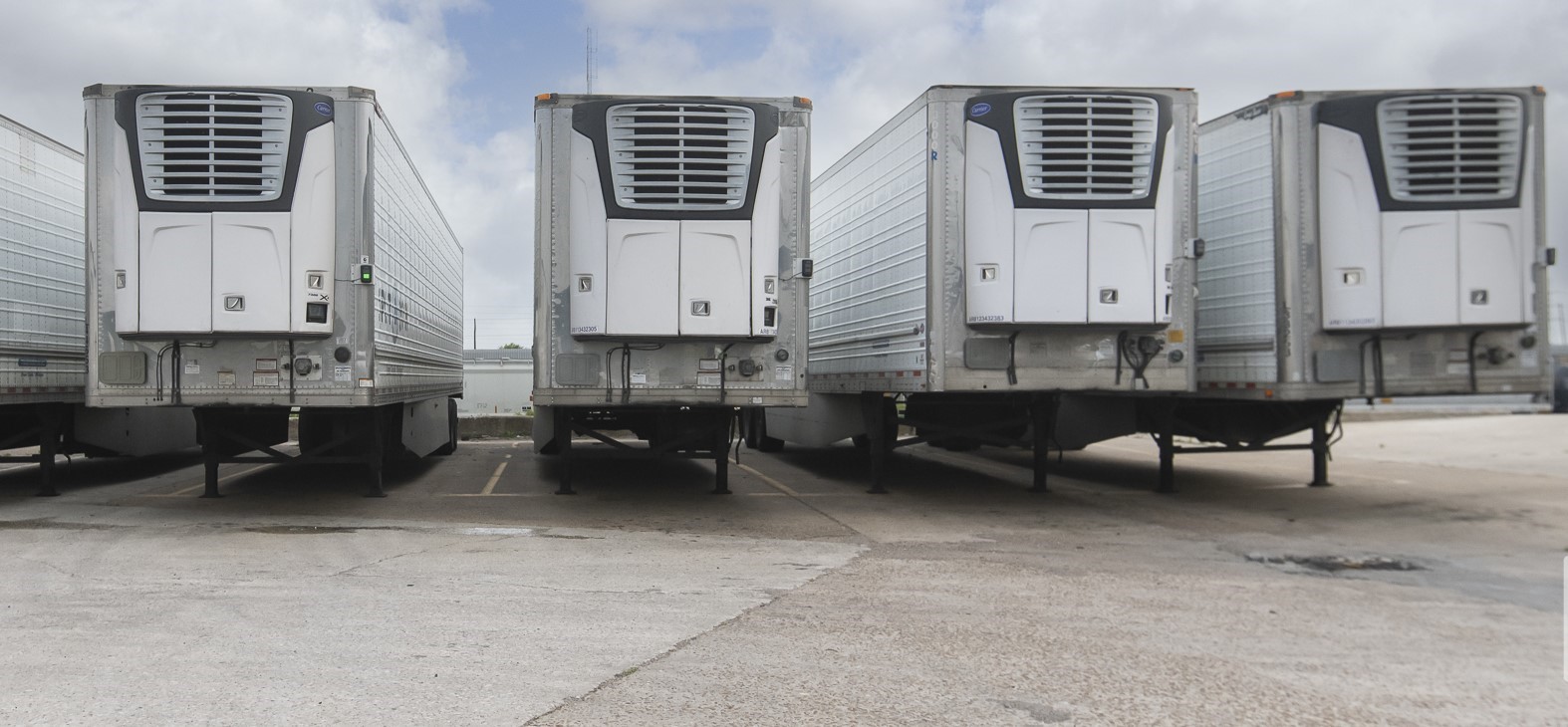As transportation companies enter 2025, selecting the optimal GPS trailer tracker solution is crucial for keeping pace with industry demands and technologies. The right device can maximize fleet efficiency, security, and data-driven decision-making.
Investing in tech that provides functional connectivity, battery life, sensor data and software integration empowers trucking companies to optimize their utilization rates and processes, helping them remain competitive in today’s fast-moving truckload logistics landscape.
Quicklook: Top trailer GPS tracker devices
- Best for small fleets: Samsara CTU
- Best for enterprise fleets: Verizon Connect
- Best for real time telematics: Motive
- Best for 4G/5G compatibility: LoneStar Oyster3
- Best for durability: Trimble
- Best for user friendliness: Geotab GO9 – Find a GPS
- Best for owner operators: CalAmp TTU-730 – Find a GPS
- Best for efficiency: Omnitracs Sylectus – Find a GPS
Why should trucking companies have a GPS tracking device for trailers?
A trailer tracking GPS enables accurate, real-time visibility into the exact location and status of trailers-in-transit, standing idle, or stopped at lots. This allows trucking companies and fleet operators enhanced monitoring and security against theft.
Tracking data also produces analytics on precise trailer utilization metrics so that inefficiencies can be identified, helping ensure units are connected to revenue-generating loads as much as possible.
When integrated properly with fleet telematics, the insights from trailer GPS tracking can significantly optimize asset performance, workflow efficiency and inform better decision making – ultimately leading to major boosts in ROI throughout strategic areas of logistics operations.
With ever-increasing demands for shipping precision and responsiveness across supply chains, transportation providers require actionable intelligence to maximize productivity.
The best GPS tracker for trailers provides valuable data to improve operations and establish performance goals, leading to advantages in service, costs, and profitability.
How does GPS trailer tracking work?
Trailer trackers work by using GPS technology to pinpoint a trailer’s location in real time, transmitting data over cellular or satellite networks to a centralized platform that fleet managers can access. Equipped with sensors, trailer trackers can monitor various aspects like location, speed, and environmental conditions. Some devices also support features such as geofencing, which alerts users when a trailer enters or exits designated areas.
8 best trailer GPS tracking systems
If you’re wondering what the best trailer tracker GPS is for trucking companies right now, you can’t go wrong with any of the options on this list.
Samsara CTU
Samsara CTU offers an intuitive, easy to use interface that enables fast setup without major training requirements — advantageous for small fleets with limited IT resources.
It provides accurate GPS location and sensor monitoring of trailers in real time, with basic reports and alerts at an affordable hardware cost and competitive monthly pricing.
These factors of usability and cost efficiency make CTU well-matched to the budget and capabilities needed for small trucking companies.
Best for: Small fleets
Special features:
- Trailer assignment
- Maintenance alerts
- Real-time customer ETAs
- Temperature monitoring
Benefits:
- Increase trailer utilization
- Reduce detention costs
- Protect temperature-sensitive loads
- Integrate trailer data into a transportation management system (TMS)
Disadvantages:
- Some reports of software bugs
- Limited third-party integration
Pricing: Customized with a free quote
Verizon Connect
Verizon Connect integrates wireless asset trackers with Verizon’s extensive LTE network coverage to ensure consistent wide-area connectivity and visibility for trailers.
The solution provides deep customization, analytics, and API integration capabilities that allow it to scale to the sophisticated needs and optimization goals of large transportation companies managing complex logistics operations.
Best for: Enterprise fleets
Features:
- Rugged and weatherproof trackers
- Runs on the Verizon network
- Trailer utilization optimization
- Hardwired and battery-powered options
Benefits:
- Improve on-time delivery
- Geofence alerts
- Reduce trailer theft
- Can track various types of trailers
Disadvantages:
- Difficult to cancel membership
- Outsourced installation
Pricing: Customized with a free quote
Motive
Motive’s equipment and trailer monitoring solution leverages advanced telematics to offer unparalleled visibility into the location, utilization, and health of your equipment. Their tracking devices help you enhance customer relationships by ensuring the right trailer reaches the correct warehouse and providing timely delivery updates in transit. Keep your equipment and trailers utilized at full capacity with real-time insight into utilization and dormancy.
Best for: Real time telematics
Features:
- 24/7 real time location tracking
- Theft detection
- Easy installation
- Long battery life
- Solar-power
- Instant reporting capability
- Over-the-air serviceability
- Historical view capability
Benefits:
- Improved security
- Increased operational efficiency
- Real time ETA updates
- Geofencing alerts
- Better customer service
Disadvantages: Occasional issue with freezing apps
Pricing: Free trial; contact Motive for details
LoneStar Oyster3
LoneStar Oyster3 provides broad 4G and 5G compatibility, offering fleet managers reliable tracking with minimal setup requirements and seamless network connectivity. This device is designed for fleets looking to future-proof their tracking systems with connectivity support for both current 4G networks and upcoming 5G expansions. It features a durable, waterproof casing and long-lasting battery, making it ideal for diverse environments and extended field use. The Oyster3 is compact, easy to install, and suited to long-term tracking applications where frequent maintenance or charging is not feasible.
Best for: 4G/5G compatibility
Features:
- 4G and 5G network compatibility
- Durable, waterproof design
- Compact size for easy placement
Benefits:
- Long battery life minimizes maintenance
- Easy installation for quick deployment
- Compatible with existing and emerging network infrastructures
Disadvantages:
- Initial hardware costs are higher
- Limited software integration options
Pricing:
Trimble
Trimble shines in the realm of durability and weather resistance. Their trackers are designed to withstand harsh conditions, ensuring reliable performance no matter the environment.
Built to withstand extreme temperatures, moisture, and shock, Trimble’s devices are well-suited for demanding industrial and construction settings. Furthermore, their long-lasting battery life ensures uninterrupted tracking, even in remote areas with limited access to power sources.
Best for: Durability
Features
- Fuel price tracking
- System alerts
- Geofencing
Benefits
- Maintenance management tools
- Engine diagnostics and alerts
- User-friendly
- Customizable reports
Disadvantages: Occasional issues with customer care
Pricing: Based on features, contract length, and fleet size
Geotab GO9

With software designed for ease-of-use, the Geotab GO9 allows new users to quickly learn the system, while customizable dashboards let fleets configure visualizations specific to their key tracking metrics and operational data needs. ‘
The device also provides simple plug-and-play installation of sensors and supports a mobile app for convenient monitoring, enabling drivers and managers to access and understand reporting without extensive technical expertise.
Best for: User friendliness
Features:
- Integrates with ELDs
- Accurate real-time tracking
- Open platform for apps and APIs
Benefits:
- Compliance with regulations
- Reliable visibility and tracking
- Custom integrations possible
Disadvantages:
- Upfront hardware investment
- Monthly connectivity fees
- Not optimized for trailers
Pricing:
- $100+ for hardware
- $15 and up for monthly plans
- Custom options cost more
CalAmp TTU-730 GPS trailer tracking device

With battery life up to six years before needing replacement, the CalAmp TTU-730 reduces the maintenance effort and cost for independent truck drivers managing their own trailer assets.
Detailed event reporting on cargo and doors also provides owner operators better insight into their equipment’s status when on the road and allows them to monitor security threats or environmental issues during long hauls.
Best for: Owner operators
Features:
- Real-time trailer tracking
- Cargo and door sensors
- Battery lasts up to five years
Benefits:
- Visibility and security of assets
- Monitor cargo and doors
- Long battery life
Disadvantages:
- Initial hardware investment
- Monthly connectivity plans
- Less rugged than some models
Pricing:
- $255 includes three years of service
- No monthly fees
Omnitracs Sylectus

In 2011, Sylectus joined the Omnitracs family. Omnitracs Sylectus focuses specifically on providing fleets with actionable data and insights to improve trailer usage, ensuring units are connected to revenue-generating loads as much as possible.
Features like real-time tracking give logistics managers the visibility to minimize idle trailers, while custom analytics on utilization metrics help fleets establish benchmarks and make operational changes to maximize the efficiency of their trailer pools.
Best for: Efficiency
Features:
- Integrates with Omnitracs platforms
- Customizable alerts and reports
- Real-time GPS trailer tracking
Benefits:
- Optimizes trailer utilization
- Enables data-driven decision making
- End-to-end fleet visibility
Disadvantages:
- Upfront investment required
- Ongoing subscription fees
- Locked into Omnitracs ecosystem
Pricing:
- Custom quote based on fleet size
- Hardware costs around $200 per asset
- Subscription fees start ~$15 monthly
Where to place a trailer GPS tracking device
Trailer trackers are typically placed in secure but accessible areas to ensure they remain functional and protected. Common placement locations include:
- Undercarriage: Hidden beneath the trailer, often near the front, for protection and reduced tampering risk.
- Inside the cargo area: Ideal for trackers with environmental sensors, allowing them to monitor temperature and humidity inside.
- Near the trailer’s front bulkhead: This location provides a clear view of the sky for GPS signal strength and is often hidden from plain sight.
- On or near the frame: Secured on a solid, accessible part of the frame, trackers here are shielded but still capable of strong signal transmission.
The placement should balance ease of installation, GPS signal strength, and protection from weather and unauthorized tampering.
Find the best GPS trailer tracker device to fit your needs
Trucking fleets of all types and scale share the common challenge of maximizing the utilization and security of expensive trailer assets that are difficult to constantly monitor visually. However, company size determines variables like budget constraints, feature needs and IT capabilities.
Large nationwide carriers may invest in custom tracking integrations, while single-truck owner-operators need simple, low-cost visibility. Yet despite these vastly different working environments, the core benefit of gaining meaningful insight into asset location remains consistent across the board.
Fleets should evaluate a trailer GPS tracker based on connectivity, battery life, sensors, analytics, and ease of use that match their specific regulations, budgets, and operational needs. Matching specific use cases to the GPS tracking device that fits ensures scaled value.
FAQ
To track mileage, these devices typically measure the distance covered by recording the GPS coordinates and calculating the distance between points over time. Advanced models can automatically log mileage for each trip, making it easy to monitor trailer usage and plan maintenance intervals based on distance traveled.es installed on the assets. This data feeds into software platforms that allow for mapping, alerts, reports and more.
The most efficient way to track trailers is by installing a dedicated GPS asset tracking device which transmits time-stamped location data through cellular networks into a management software system. This provides real-time visibility plus historical reports on each trailer.
Most GPS trackers do require an ongoing service subscription to transmit data over cellular networks, though a few models allow for one-time purchase with free basic services. Subscription fees enable access to tracking platform data, remote updates, and communication costs.
While it’s technically possible to use an AirTag to track a trailer, it’s not an ideal solution due to limitations in range and update frequency. For reliable, real-time trailer tracking, it’s generally recommended to use dedicated GPS tracking devices designed specifically for vehicle and asset tracking in the transportation industry.
Yes, you can put a tracker on a trailer, and many fleet managers and trailer owners do so for security and logistics purposes. However, it’s important to choose a tracker specifically designed for vehicle or asset tracking, as consumer devices like AirTags may not be ideal due to potential legal issues, limited range, and lack of features tailored for commercial tracking needs.





